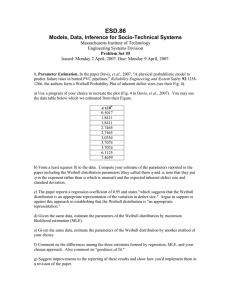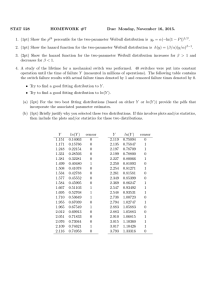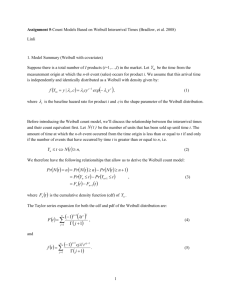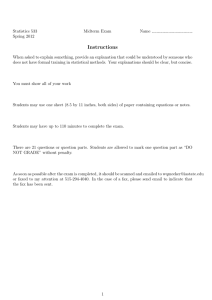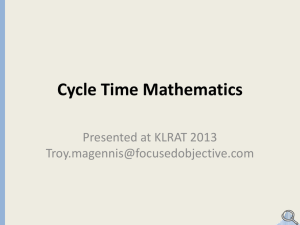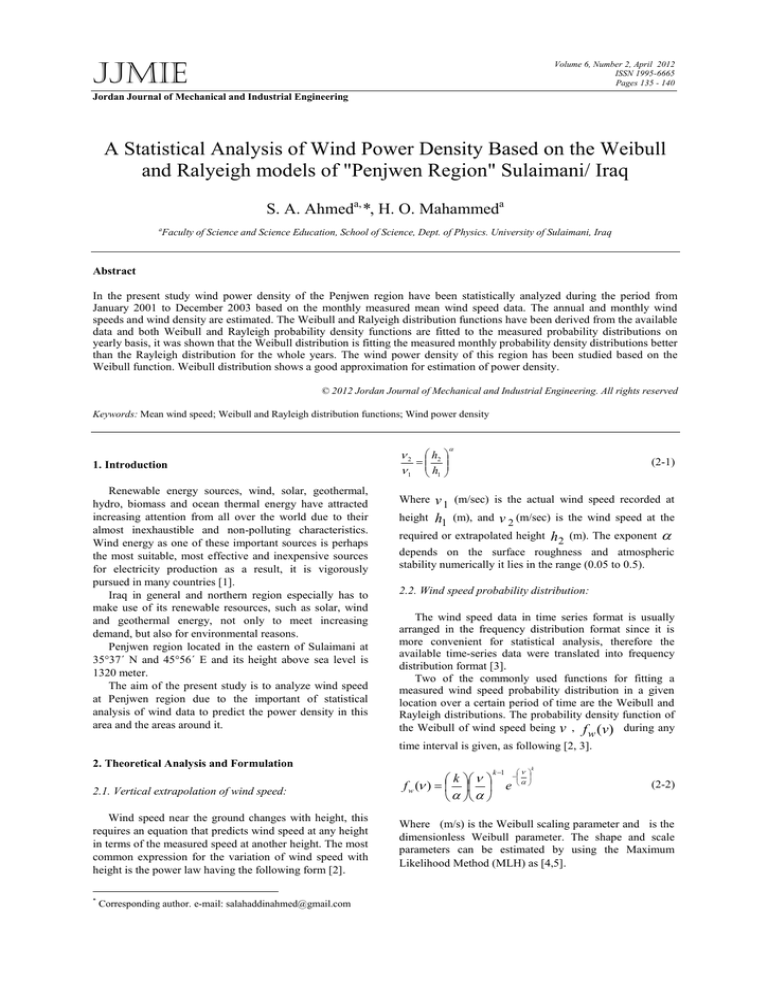
JJMIE
Volume 6, Number 2, April 2012
ISSN 1995-6665
Pages 135 - 140
Jordan Journal of Mechanical and Industrial Engineering
A Statistical Analysis of Wind Power Density Based on the Weibull
and Ralyeigh models of "Penjwen Region" Sulaimani/ Iraq
S. A. Ahmeda,*, H. O. Mahammeda
a
Faculty of Science and Science Education, School of Science, Dept. of Physics. University of Sulaimani, Iraq
Abstract
In the present study wind power density of the Penjwen region have been statistically analyzed during the period from
January 2001 to December 2003 based on the monthly measured mean wind speed data. The annual and monthly wind
speeds and wind density are estimated. The Weibull and Ralyeigh distribution functions have been derived from the available
data and both Weibull and Rayleigh probability density functions are fitted to the measured probability distributions on
yearly basis, it was shown that the Weibull distribution is fitting the measured monthly probability density distributions better
than the Rayleigh distribution for the whole years. The wind power density of this region has been studied based on the
Weibull function. Weibull distribution shows a good approximation for estimation of power density.
© 2012 Jordan Journal of Mechanical and Industrial Engineering. All rights reserved
Keywords: Mean wind speed; Weibull and Rayleigh distribution functions; Wind power density
1. Introduction
Renewable energy sources, wind, solar, geothermal,
hydro, biomass and ocean thermal energy have attracted
increasing attention from all over the world due to their
almost inexhaustible and non-polluting characteristics.
Wind energy as one of these important sources is perhaps
the most suitable, most effective and inexpensive sources
for electricity production as a result, it is vigorously
pursued in many countries [1].
Iraq in general and northern region especially has to
make use of its renewable resources, such as solar, wind
and geothermal energy, not only to meet increasing
demand, but also for environmental reasons.
Penjwen region located in the eastern of Sulaimani at
35°37´ N and 45°56´ E and its height above sea level is
1320 meter.
The aim of the present study is to analyze wind speed
at Penjwen region due to the important of statistical
analysis of wind data to predict the power density in this
area and the areas around it.
2 h2
1 h1
Where
height
v1
h1
(2-1)
(m/sec) is the actual wind speed recorded at
(m), and
v 2 (m/sec)
is the wind speed at the
h2 (m). The exponent
depends on the surface roughness and atmospheric
stability numerically it lies in the range (0.05 to 0.5).
required or extrapolated height
2.2. Wind speed probability distribution:
The wind speed data in time series format is usually
arranged in the frequency distribution format since it is
more convenient for statistical analysis, therefore the
available time-series data were translated into frequency
distribution format [3].
Two of the commonly used functions for fitting a
measured wind speed probability distribution in a given
location over a certain period of time are the Weibull and
Rayleigh distributions. The probability density function of
the Weibull of wind speed being v , f (v) during any
w
time interval is given, as following [2, 3].
2. Theoretical Analysis and Formulation
2.1. Vertical extrapolation of wind speed:
Wind speed near the ground changes with height, this
requires an equation that predicts wind speed at any height
in terms of the measured speed at another height. The most
common expression for the variation of wind speed with
height is the power law having the following form [2].
*
Corresponding author. e-mail: salahaddinahmed@gmail.com
k
f w ( )
k 1
e
k
(2-2)
Where (m/s) is the Weibull scaling parameter and is the
dimensionless Weibull parameter. The shape and scale
parameters can be estimated by using the Maximum
Likelihood Method (MLH) as [4,5].
136
© 2012 Jordan Journal of Mechanical and Industrial Engineering. All rights reserved - Volume 6, Number 2 (ISSN 1995-6665)
n k
i ln( i ) ln( i )
k i 1 n
i 1
n
k
i
i 1
1
Where
(2-3)
1/ 2
1 n
a ik
2 i 1
Where
vi
(2-4)
is the wind speed in time stage
i
and
n
R
Weibull distribution in which the shape parameter k is
assumed to be equal to 2. From Equation (2-2) the
probability density functions of the Ralyeigh distribution
given by [3].
2
(2-5)
(2-10)
The errors in calculating the power densities using the
distribution models (Weibull and Rayleigh) in comparison
to values of the Probability density distributions derived
from measured values can be found using the following
formula [2,3].
is
the number of non-zero wind data points.
The Ralyeigh f (v) distribution is a special case of the
2
f R ( ) 2 e a
a
1
Vm a1
2
Error %
Pw, R Pm, R
Pm, R
(2-11)
Where PW , R (w/m2) is the mean power density
calculated from either the Weibull or Rayleigh function
used in the calculation of the error, and Pm, R is the wind
power density for the probability density distribution,
derived from measured values which serves as the
reference mean power density.
2.3. Wind power density function:
3. Results and Discussion
The evaluation of the wind power per unit area is of
fundamental importance in assessing wind power projects,
it is well known that the power of the wind at speed V
through the blade sweep area A increases as the cube of its
velocity and is given by [2,6].
Data for wind speed in the present calculation were
obtained during the period 2001 to 2003 taken from the
meteorological directorate center of Sulaimani. The main
results obtained from the present study can be summarized
as follows.
The monthly mean wind values estimated from the
available data for the overall and individual three years are
presented in Table (1). It is seen in Table (1) that the
highest wind speeds 7.65 m/s occurs in April and June in
year 2002. While lowest wind speed 4.88 m/s occur in
August in year 2003. The variation of wind speeds often
described using the Weibull two-parameter density
function. This is statistical method which widely accepted
for evaluation local wind local probabilities and
considered as a standard approach.
Maximum Likelihood Method was used to calculate
bothWeibull’s parameters, scale and shape, as shown in
Table (1), it is seen from the Table that, while the scale
factor varies between 6.19 to 9.73 m/s, the shape factor
ranges from 8.84 to 15.00 for location analyzed.
The annual probability density distributions obtained
from the Weibull and Rayleigh models were compared to
the measured distributions to study their suitability. The
annual comparison shows that the Weibull model better
than the Rayleigh model to fit the measured probability
density distribution as shown in Figure (1), while Figure
(2) shows the Weibull distribution of wind speeds all over
the data for each year for the studied area.
Pv
1
A 3
2
(2-6)
Where (kg/m3) is the mean air density, the value
1.069 kg/m3 is used in this work [7]. This depends on
altitude, air pressure and temperature.
The expected monthly or annual wind power density
per unit area of a site based on a Weibull probability
density function can be expressed as follows[8].
Pw
1 3 3
a 1
2
k
Where is the gamma function and
scale parameter (m/s) given by:
P
(2-7)
a
is the Weibull
Vm
1
1
k
(2-8)
The two significant parameters k , a are closely related
to the mean value of the wind speed Vm .
By extracting a from Equation (2-8) and setting k
equal to 2, the power density for the Rayleigh model is
found to be [9].
PR
3
Vm
(2-9)
© 2012 Jordan Journal of Mechanical and Industrial Engineering. All rights reserved - Volume 6, Number 2 (ISSN 1995-6665)
Table 1: Monthly mean wind speeds, wind power density and the two Weibull parameters (shape and scale).
Jan
Feb
Mar
Apr
May
Jun
Jul
Aug
Sep
Oct
Nov
Dec
Shape
Scale
2001
Mean Wind Speed
(m/sec)
2002
2003
Weibull
6.43
7.13
7.13
5.56
7.13
6.26
6.43
7.13
7.13
5.56
7.13
6.26
15
6.86
7.13
6.26
6.61
7.65
6.61
7.65
6.09
6.61
6.43
5.22
5.22
5.22
8.84
6.75
5.91
6.26
5.74
5.74
6.43
6.09
5.39
4.88
5.39
6.09
7.13
6.26
11.01
6.19
6.49
6.55
6.49
6.32
6.72
6.67
5.97
6.21
6.32
5.62
6.49
5.91
Wind Power Density
(w/m²)
Rayleigh
measured
6.30
6.39
6.17
6.21
6.58
6.52
5.73
5.66
5.92
5.79
6.63
5.99
6.51
6.36
6.28
6.57
6.59
6.80
5.82
5.90
6.05
5.64
6.28
5.80
120
Number of Observations
100
80
60
40
20
0
0
1
2
3
4
5
6
7
Velocity m/sec
Figure 1: Weibull and Rayleigh comparisons of the actual probability distribution of the wind.
8
137
138
© 2012 Jordan Journal of Mechanical and Industrial Engineering. All rights reserved - Volume 6, Number 2 (ISSN 1995-6665)
Figure 2: Yearly Weibull probability density distribution of each year for the period of (2001- 2003).
interesting to note that the highest power density value
occur in the Spring and Summer months of March, May
(2002) and May, July (2001) with the maximum value of
(53.49, 53.12) and (54.87, 50.83) w/m2 respectively. The
power densities in the remaining moths are between these
two groups of low and high as shown in Figure (4).
The power densities calculated from the measured
probability density distribution and those obtained from
the models are shown in Figure (3). The power density
shows a large month to month variation, the minimum
power densities occur in the February and September
(2003) with 14.55 and 14.45 w/m2 respectively, it is
200
180
Weibull
Rayleigh
Actual Data
Power Density (W/m2 )
160
140
120
100
80
60
40
20
0
Jan
Feb
Mar
Aprl May
Jun
July Aug Sept Oct
Nov
Dec
Month
Figure 3: Wind power density obtained from the actual data versus those obtained from the Weibull and Rayleigh models on a monthly
basis.
© 2012 Jordan Journal of Mechanical and Industrial Engineering. All rights reserved - Volume 6, Number 2 (ISSN 1995-6665)
139
Wind Power Density (W/m2 )
60
Year 2001
Year 2002
Year 2003
50
40
30
20
10
Jan
Feb
Mar
Apr
May
Jun
Jul
Aug Sep
Oct
Nov
Dec
Months
Figure 4: Monthly Weibull probability density distribution for the period of 2001- 2003 for the studied area.
Errors in calculating the power densities using the
distributions (Weibull and Rayleigh models) in
comparison to those using the measured probability
density distributions are presented in Figure (5). The
highest error values occur in August and September with
9.27% and 6.96% for the Weibull model respectively, the
power density as estimated by the Weibull model has a
very small error value 2.59% in February. The monthly
analysis shows that the highest error value using the
Rayleigh model occur in November with 4.86%, whereas
the smallest error in the power density calculation using
Raleigh model is 2.28% in December.
15
Weibull
Rayleigh
10
Error (%)
5
0
-5
-10
-15
Jan
Feb
Mar
Apr
May
Jun
Jul
Aug
Sep
Oct
Nov
Dec
Month
Figure 5: Error values in calculating the wind power density on monthly basis obtained from the Weibull and Rayleigh models in reference
to the wind power density obtained from the measured data.
4. Conclusions
Wind characteristics of Penjwen have been analyzed
statistically, wind speed data were collected for a period of
three years (2001-2003). The probability density
distributions and power density distributions were derived
from the time series data. Two probability density
functions have been fitted to the measured probability
distributions on a monthly basis, based on the Weibull and
140
© 2012 Jordan Journal of Mechanical and Industrial Engineering. All rights reserved - Volume 6, Number 2 (ISSN 1995-6665)
Rayleigh models. The most important outcomes of the
study can be summarized as follows:
The Weibull distribution is fitting the measured
monthly probability density distributions better than
the Rayleigh distribution for the whole years.
References
[1]
[2]
[3]
[4]
Mahyoub H.Albuhairi, “Assessment and Analysis of Wind
Power
density
in
Taiz
–Republic
of
Yemen”Ass.Uni.Bull.Environ.Res.Vol9,No.2,pp,
13-21,
October, 2006.
Mahyoub H.Albuhairi, “A Statistical Analysis of Wind
Speed Data and an Assessment of Wind Energy Potential in
Taiz-Republic of Yemen”, Ass.Uni.Bull.Environ.Res.Vol9,
No.2, pp 21-33, Oct.2006.
Ali Naci Celik,”A Statistical Analysis of Wind power
Density Based on The Weibull and Rayleigh Models at the
southern Region of Turkey” Renewable Energy Vol.29, pp
593-604,2003.
Zaid
Hatahet,
“Wind
Data
Analyzer”
2006,
www.hatahet.net.
[5]
[6]
[7]
[8]
The Rayleigh distribution provides better power
density estimations in nine months than the Weibull
distribution.
The yearly average error values in calculating the
power densities using the distributions in comparison
to those using the measured probability density
distributions shows a large month to month variation
due to the difference of the shape parameters.
S. Mathew , “Wind Energy” (2006),Electric Edition ,
Springer (NL).
Wei zhou, Hongxing Yang, Zhaohong Fang, “Wind Power
Potential and Characteristic Analysis of the Pearl River
Delta Region, China” Renewable Energy Vol.31, (2006), pp
739-753.
Salahaddin A. Ahmed, "Wind Analysis and Distribution of
Wind Energy Potential over Iraqi Kurdistan Region” 2009,
PhD Thesis, Univ. of Sulaimani Coll. of Science.
O.A.Jaramillo, R. Saldana, U. Miranda, “Wind Power
Potential of Baja California Sur, Mexico ” Renewable
Energy Vol.29,(2004),pp 2087-2100.
Adrian Ilinca, Ed McCarthy, Jean-Louis Chaumal, JeanLouis Retiveau Renewable Energy Vol.28, (2003), pp 1881189.


